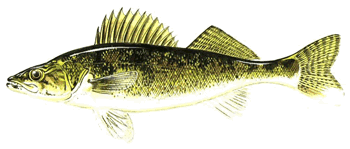Back to Previous Page
WALLEYE

At-a-Glance
- Scientific Name: Sander vitreus
- Found in Illinois: Mainly in northern Illinois
- State Average: 14"
- State Record: 15lbs/1oz (2012)
- Best Lures: minnows, minnow-spinner combinations, spinners, crankbaits, night crawlers, worms, frogs, crayfish
Knowing the seasonal movement of this fish is one of the key factors for successful walleye fishing. In the spring, fishing is typically poor as this is their reproductive period.
As aquatic vegetation emerges and forms cover, walleye gravitate to natural structures and weed beds. Fast-retrieving crank-baits that can be fished over land points and rocky areas are often successful.
In the fall, walleye can be concentrated is the deeper waters around gravel bars and rocky reefs. Presentation should be slower in fall, with the bait or lure fished close to the bottom.
Habitat: Walleye are typically found in large rivers with clear water or deep, weedless lakes with clean bottoms of gravel, rock, sand, or hard clay. However, the best walleye populations occur in large windswept, moderately fertile lakes with feeding grounds consisting of shoals, bars, and shallows. In Illinois, walleye are found primarily in large rivers and streams in the northern part of the state. The largest populations are in the Mississippi, Rock, and Kankakee Rivers. Smaller numbers occur in the Fox Chain O'Lakes region and in some strip-mine lakes. Adult walleye are mostly piscivorous (they feed mostly on other fish). During the day they tend to move to deeper water to feed, while moving closer to shore at night.
Feeding and Habits: Generally, during the day walleye tend to stay in deeper water to feed, while moving closer to shore at night. Mainstays of their diet consist of crayfish, frogs, snails, minnows, yellow perch, gizzard shad, suckers, and bluegill. As a top predator, walleye can consume large quantities of fish.
Reproduction: Walleye spawn when the water temperature ranges from 42° - 54°F. Male walleye reach sexual maturity around two to three years old and between 12-13.5 inches long. Females mature when they are four to five years old and 15-17 inches in length. Small males are the first to seek spawning areas shortly after the ice melts (March-April). Walleye are known as broadcast spawners, with no nest or parental care involved. One or more males accompany a female to the spawning areas where the eggs are deposited at random over a rocky or gravel bottom in water one to four feet deep. Fertilized eggs are left unattended and hatch in twelve to eighteen days later.



